|
|
|
Sort Order |
|
|
|
Items / Page
|
|
|
|
|
|
|
| Srl | Item |
| 1 |
ID:
170631
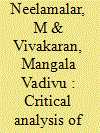

|
|
|
|
|
| Summary/Abstract |
Jihadism’ (also known as the jihadi movement) is a popular term that signifies the Islamic terror movement which thrives on extremist ideologies and violence. In addition to the conventional practices, the online medium is currently being employed for disseminating these extremist ideologies across the globe. Radicalisation and recruitment of geographically dispersed individuals as ‘jihadists’ for supporting Islamic terror activities tend to be the primary intent for using the digital platforms as the medium of communication in this context. One such initiative by the Lashkar-e-Taiba of Jammu and Kashmir was the release of the ‘Wyeth: The Resistance in Flow’, an e-magazine which was launched on April 2018. The first issue which was posted with an open access option was primarily designed to influence the Indian youth population through the radical interpretations of Islam. Hence, it is crucial to analyse and understand the jihadi discourse of the Wyeth magazine in order to curb and counter-attack such initiatives at its initial phase. For this purpose, the present study aims to examine the content of the Wyeth magazine and analyse the basic traits of the jihadi propaganda and its potential to aid in the self-radicalisation process.
|
|
|
|
|
|
|
|
|
|
|
|
|
|
|
|
| 2 |
ID:
181738
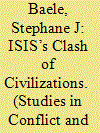

|
|
|
|
|
| Summary/Abstract |
Depictions of the West abound in the propaganda produced by the self-proclaimed “Islamic State,” presenting to potentially sympathetic audiences an overwhelmingly negative image of a supposedly homogeneous political entity. Combining quantitative and qualitative language and visual analysis, we systematically expose the various facets of this image and analyze the overall picture. Drawing on the “clash of civilizations” literature as well as on research on extremist language, we conceptualize this presentation of the West as a powerful radicalizing voice shaping today’s global civilizational politics.
|
|
|
|
|
|
|
|
|
|
|
|
|
|
|
|
| 3 |
ID:
175724
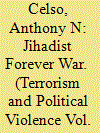

|
|
|
|
|
| Summary/Abstract |
It has been over a year since the last vestige of Islamic State of Iraq and al-Sham’s (ISIS) caliphate project in the town of Baghuz was captured by American-backed Syrian-Kurdish paramilitary forces. 1 A culmination of four years of bloody warfare between an international coalition of sixty plus nations and ISIS’s global terror network whose size and endurance proved difficult to overcome. Despite the death of some tens of thousands of its fighters and the loss of its transnational state, ISIS remains a potent insurgent-terror movement.
|
|
|
|
|
|
|
|
|
|
|
|
|
|
|
|
| 4 |
ID:
155437
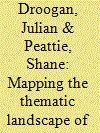

|
|
|
|
|
| Summary/Abstract |
This article presents a thematic network analysis of Dabiq—a prominent English-language e-magazine produced by the Islamic State. Through formal qualitative analysis, the article examines the e-magazine’s first 13 issues in order to better understand its structure, evolution and intended audiences. In terms of structure, thematic network analysis provides a comprehensive and holistic understanding of Dabiq’s themes, identifying a range of concerns that are broader and more complex than is often supposed by academic and professional commentators. In terms of evolution, this analysis reveals a thematic landscape that has demonstrated considerable dynamism over four distinct phases throughout the magazine’s publication. In terms of understanding audiences, it is argued that Dabiq has been particularly engaged with the manipulation of group-level identities in an apparent attempt to garner support from global audiences. Themes related to allegiance, the group’s strengths and victories, and territorial expansion all feature consistently and prominently. They seek to create an in-group identity centred on victory, and to frame the Islamic State’s expansion and successes as a group achievement on behalf of Islam itself. Additionally, Dabiq provides the Islamic State with an opportunity to justify its actions and its religious authenticity to a broader Muslim audience, and thus provide the Islamic State with legitimacy beyond its borders. Recognising these thematic dynamics will be important for those engaged in counter-messaging and the development of counternarratives.
|
|
|
|
|
|
|
|
|
|
|
|
|
|
|
|
| 5 |
ID:
163194
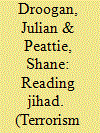

|
|
|
|
|
| Summary/Abstract |
Al Qaeda in the Arabian Peninsula’s Inspire magazine has received attention within Western academia and media for its role in inspiring and instructing a series of homegrown terrorist attacks. Reporting on the magazine often characterises it as a Western-centric instrument of jihadi discourse. This characterisation, while broadly accurate, is in need of refinement. Using a modified version of Jennifer Attride-Stirling’s method of thematic network analysis, this research visualises and analyses the narrative themes contained within fourteen issues of Inspire magazine. It demonstrates that the magazine’s narrative extends well beyond the Western world. In reality, Inspire’s themes centre not only on the West and its Muslim populations, but on local politics and broader religious issues. The magazine’s thematic focus has also shifted over time—particularly in response to (a) political volatility in the Middle East and North Africa, (b) the killing of prominent jihadists, and (c) the execution of successful individual jihad operations. Throughout these periods of change, Inspire struggled to maintain focus on its anti-Western narrative and proved easily distracted by local issues and the “martyrdom” of Al Qaeda leaders. Understanding Inspire’s thematic landscape and its shifting character prove important in understanding and responding effectively to its jihadi discourse.
|
|
|
|
|
|
|
|
|
|
|
|
|
|
|
|
| 6 |
ID:
120327
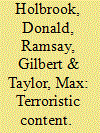

|
|
|
|
|
| Publication |
2013.
|
| Summary/Abstract |
In this article we offer a first attempt at providing a set of universal grading criteria for determining on what basis, and how far, an item of discursive content can be considered "terroristic." In doing so, we draw loosely on the existing COPINE scale for child abuse images. The scale described in the article is not intended to reflect actual risk of engagement in terrorist violence, nor is it intended to have evidential validity in relation to offenses in certain jurisdictions relating to "terrorist publications." Rather, by formalising assumptions which seem already to be latent in the literature on terrorist use of the Internet, it aspires to serve as a starting point for a more methodologically coherent approach to relationships between content-particularly online content-and terrorism.
|
|
|
|
|
|
|
|
|
|
|
|
|
|
|
|
|
|
|
|
|